John, who runs a website, recently encountered a strange problem. His website statistics showed that more and more people were visiting his site, which was great news. But there was a catch – even though there were more visitors, he wasn’t seeing the increase in leads or sales he had expected. This was quite confusing for him.
So, John decided to dig deeper to figure out what was happening. To his surprise, he discovered that a big chunk of this ‘traffic’ wasn’t actual people visiting his site but rather bots. This was a bit of a shock to him.
Realizing this, John started learning about ‘website bot detection.’ This was all about finding ways to distinguish real visitors from these fake bot visitors. He decided to use some bot detection tools on his website.
With these tools, John could now filter out the fake bot traffic. This gave him a much clearer understanding of how his website was doing. Now, he could see the true performance of his site and focus his marketing efforts more effectively on real, potential customers. It was a big step forward for him in managing his website.
Understanding Website Bot Detection
Bots on the internet come in all sorts of types, and it’s essential to know the difference between good and bad bots. The good bots, like the ones used by search engines or social media sites, help a lot. They go through your website and help get your content out there for people to see.
But then, there are the bad bots. These are the ones you need to watch out for. They do things like scrape your web content without permission, send spam, and even try to break into people’s accounts. This kind of bot activity can lead to serious problems, like unauthorized access to your site, people taking over accounts, and even data being stolen.
Telling the difference between regular people visiting your site and these bots can be tricky. That’s because the sneaky bots try to act like humans to avoid being caught. But this is where bot management solutions come into play. These affiliate marketing tools are super important for stopping the bad bots from messing with your site and ensuring that the real, legit users have a safe experience.
One key thing that website owners can do is keep an eye on their traffic patterns. A sudden traffic spike can often signal that bots are at work. Recognizing these signs early can help in dealing with bot traffic effectively.
How Bots Affect Lead Quality and Intent
Bots can throw a wrench in the works when generating leads for your business. One of the main issues they cause is creating fake leads. This happens when bots fill out forms on your website, pretending to be potential customers.
They leave bogus information, which means your marketing team might waste time chasing leads that don’t actually exist. It’s crucial to understand how these bots operate so you can stop them in their tracks and make sure you’re only dealing with real, quality data-driven leads.
Another big problem with bots is click fraud. They go around clicking on ads, making fake content, and messing up your understanding of customer behavior. This can lead to a skewed view of your conversion rates and make you think you’re doing better (or worse) than you are. Recognizing the patterns these bots follow can help your company get a more accurate picture of lead scoring and confirm that the information you’re getting is from real people.
The impact of bots goes beyond just messing up data – they can also hit your wallet hard. When you spend your marketing budget, you assume you’re reaching real users. But if much of your internet traffic is just bots, that’s money down the drain. Spotting these bot patterns is super important. It helps cut down on fake traffic, reduces the risk of ad fraud, and ensures your online advertising dollars are being spent effectively.
Can bots be detected?
Now that we understand the consequences of ignoring bot detection, let’s explore strategies to boost lead engagement with effective bot detection techniques. Utilizing third-party fraud detection tools, analyzing and monitoring website traffic patterns, verifying user data, and screening affiliates and partner agencies can enhance lead-generation efforts and prevent bot activity.
Detecting Bots in Lead Generation: Enhanced Strategies and Tools
Understanding the significant impact of bots on lead generation necessitates adopting robust bot detection techniques. Incorporating third-party fraud detection tools, along with meticulous analysis and monitoring of website traffic patterns, is crucial in distinguishing between legitimate users and malicious bots. By verifying user data, such as email addresses and phone numbers, and rigorously screening affiliates and partner agencies, businesses can significantly boost their lead-generation efforts and safeguard against malicious bot traffic.
Are bots visiting my website?
The functionality of these tools is deeply rooted in complex algorithms that meticulously scrutinize user behavior. This allows for a clear differentiation between genuine human traffic and bot behavior. This is critical when bots use fake names or perform repetitive tasks to mimic human activity.
CPV One, a premier cloud-based affiliate marketing tracker, stands out in this landscape. It is adept at identifying and managing traffic that originates from various sources, including bots or proxies. CPV One’s tracking capabilities are particularly crucial when there’s a sudden increase in page views or when traffic patterns deviate from the norm. Additionally, its Extra Tokens feature allows users to capture detailed information about bots, including identifying a visitor as a bot (true or false), the bot’s name, and its type, such as search engine bots, crawlers, social media agents, and more.
By deploying CPV One and similar fraud detection tools, businesses can significantly enhance the quality of their lead techniques for lead generation and prospecting. These tools ensure that marketing efforts are concentrated on legitimate users who exhibit typical human behavior. Integrating a Web Application Firewall (WAF) alongside these tools further bolsters security measures, offering protection against attackers and unauthorized API access. CPV One serves as an efficient bot manager, aiding in identifying bot traffic patterns. This feature is invaluable for differentiating between various forms of bots, including search engine bots, web crawlers like spiders, chatbots, and more malevolent bots, ensuring comprehensive bot management.
Continuing the discussion on the utility of CPV One in managing bot traffic, let’s delve into how CPV One can be practically applied in a campaign scenario as a case study to showcase its bot-tracking capabilities.
Case Study: Implementing CPV One for Bot Traffic Management
- Setting Up the Campaign: Initially, I set up the campaign on the CPV One platform. This includes defining the tracking domain, the data options to be tracked, the traffic source, and other tracking tokens.
- Identifying Bot Traffic: Later, I added website bot tracking to the campaign. However, a deeper analysis using CPV One’s bot detection features, like ‘Is Bot’, ‘Bot Name’, and ‘Bot Type’, reveals if a significant portion of the traffic is from bots.
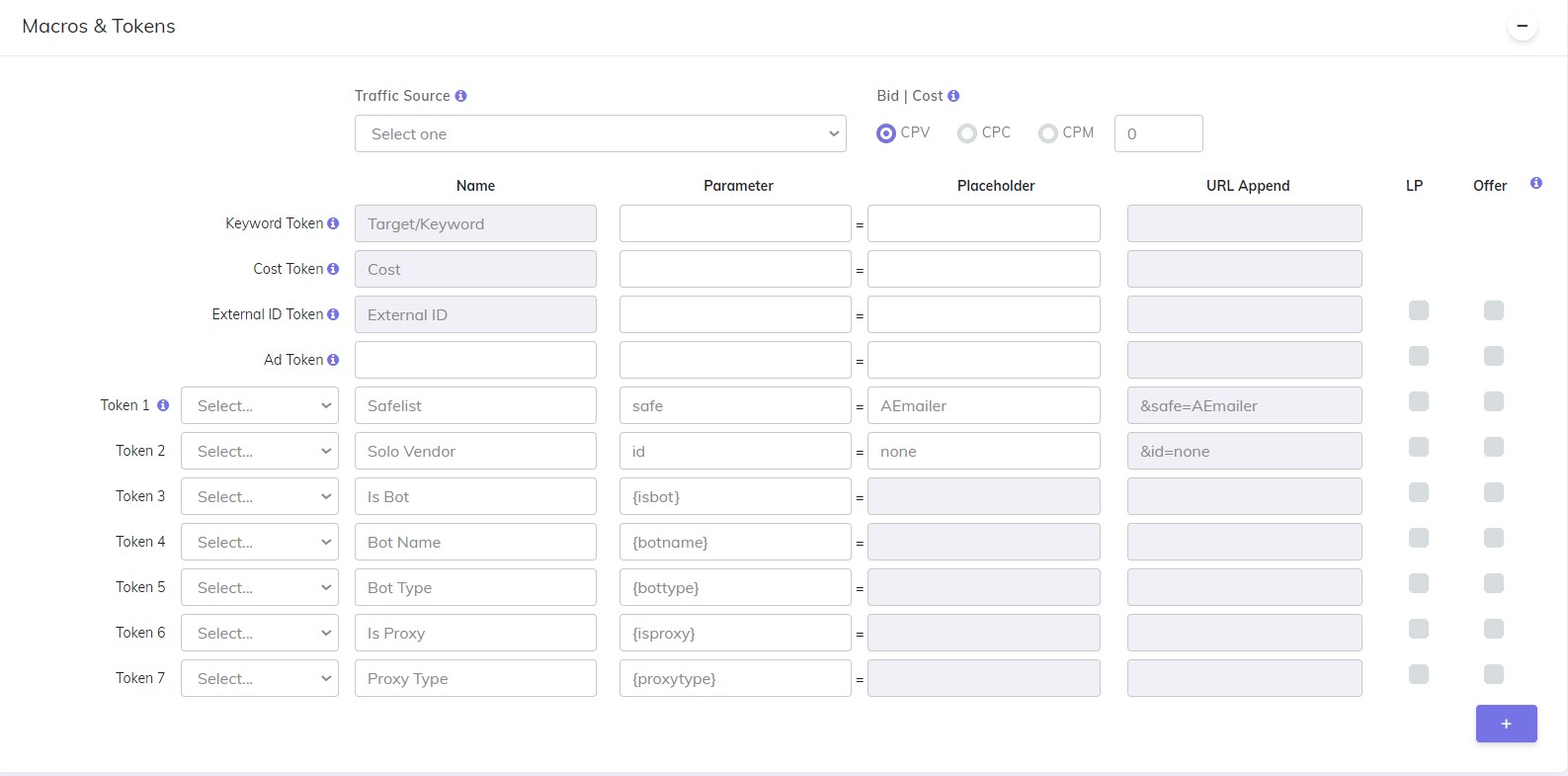
As I explained, I initially launched the campaign without implementing bot tracking but later integrated this crucial feature. Why did I do this? To demonstrate a powerful strategy CPV One offers for those who suspect anomalies in their paid traffic.
Picture this: Your paid advertising efforts are successfully driving growing subscribers. However, there’s a catch – these subscribers are unusually inactive. They don’t engage with your emails or respond to your calls to action. This raises a red flag: Is your traffic generation genuinely 100% authentic?
This is where the magic of adaptable tracking comes into play. You can seamlessly add any specific parameters you need to monitor at any given time, offering unparalleled flexibility and insight. In my case, I added bot and proxy traffic.
I opted for safelists as my traffic source. The result? An explicit, undeniable confirmation that all the traffic directed to our campaign was, indeed, real. This approach validates your audience’s authenticity and empowers you to make data-driven decisions to enhance your marketing strategy.
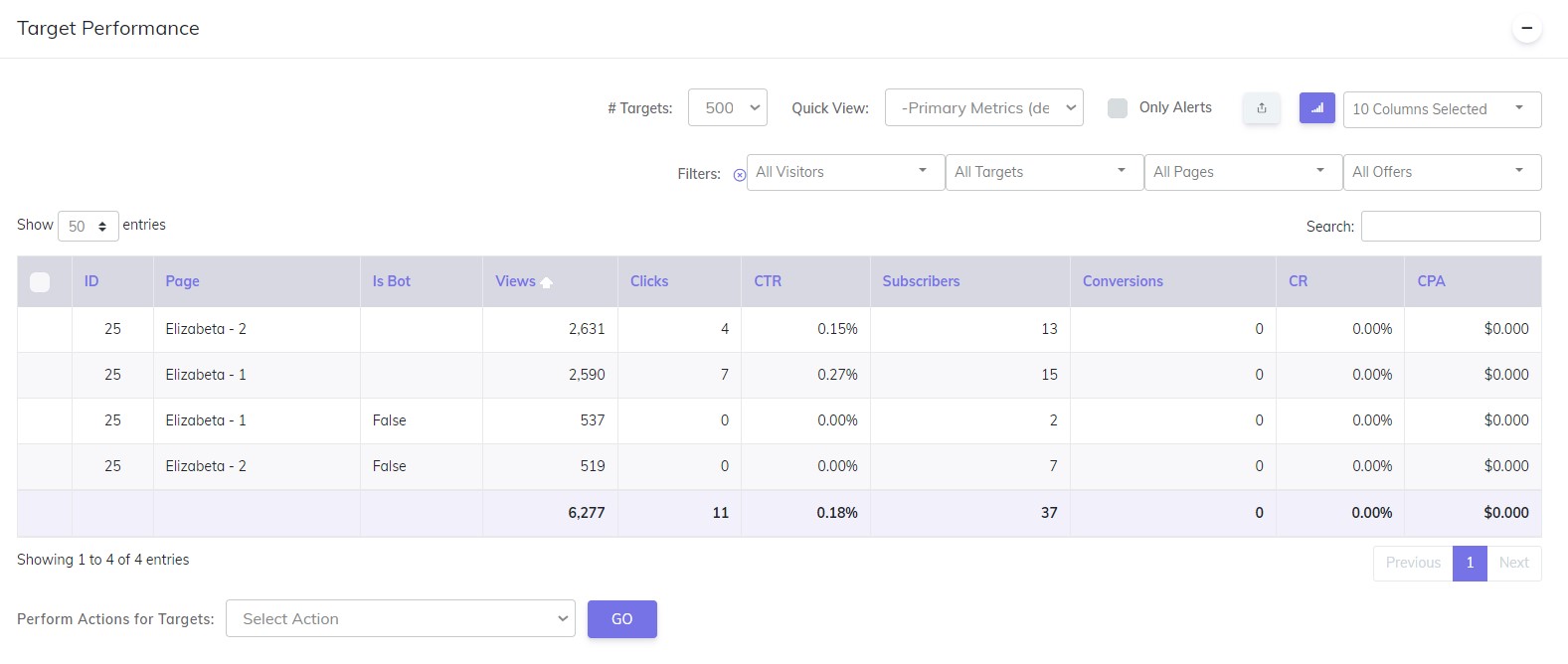
In this campaign, eighteen visitors utilized public proxy servers, a common practice in affiliate marketing. You must know how to track affiliate links and understand the statistics to bring the right decisions.
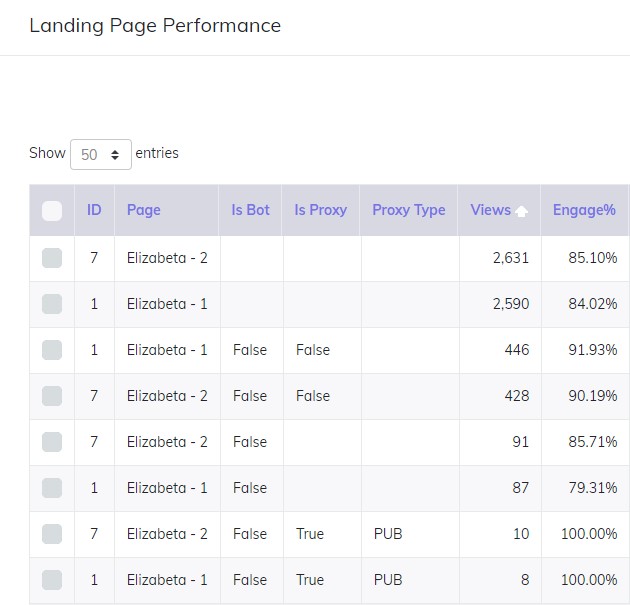
What if we discovered that some of our campaign’s traffic was not from real people but bots?
Let’s use the traffic from proxy servers as an example to explain how to find, block, and redirect the bot traffic.
To check this out, I’d go to the section where we can see stats about our visitors. This part shows us who is visiting our campaign right at that moment. It gives us all sorts of info about each visitor, like where their internet connection is coming from (their IP address), whether they might be a bot, what kind of device they’re using, and which country they’re in. This is really useful for figuring out if we’re dealing with bots and deciding what to do about them.
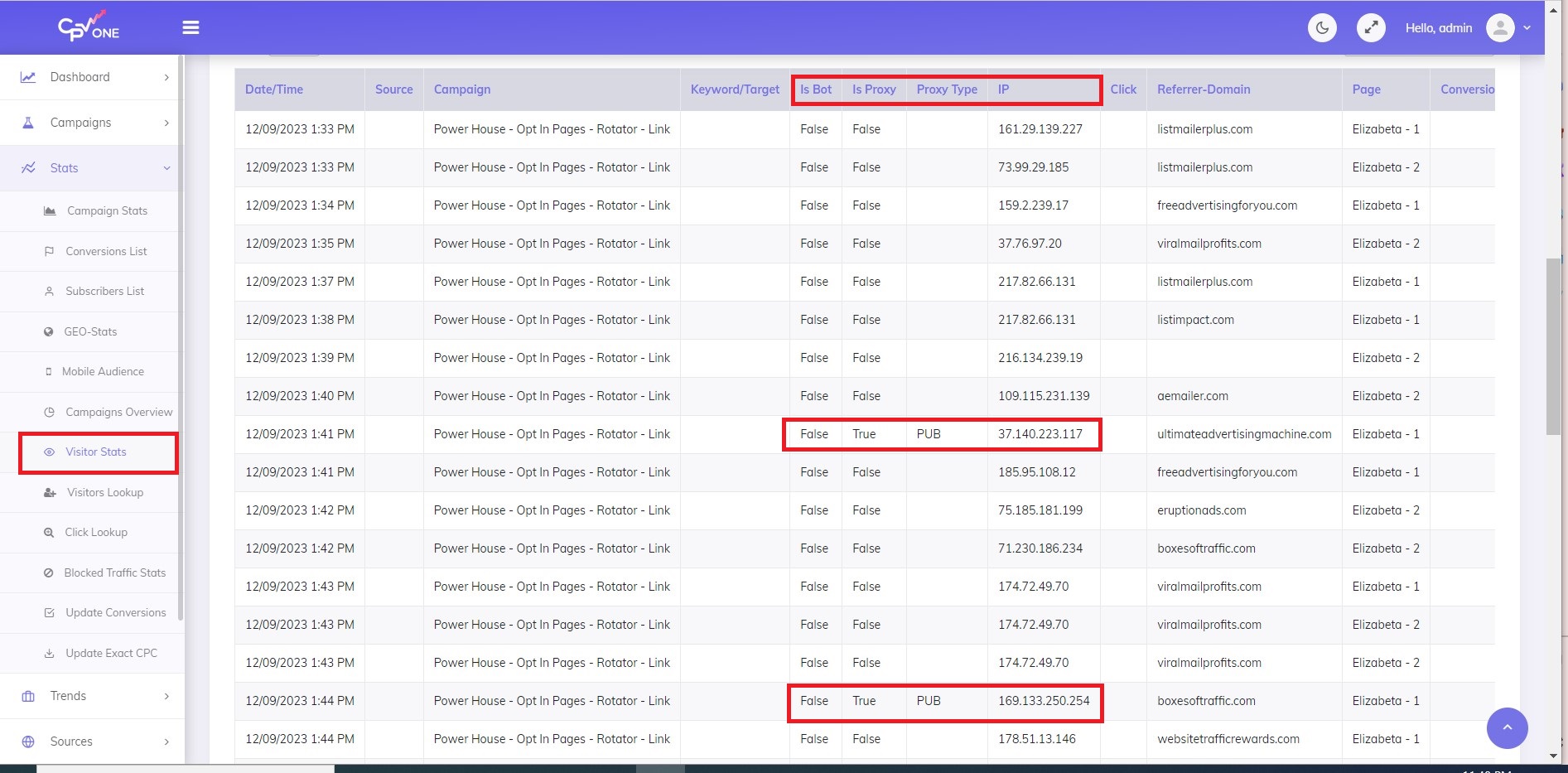
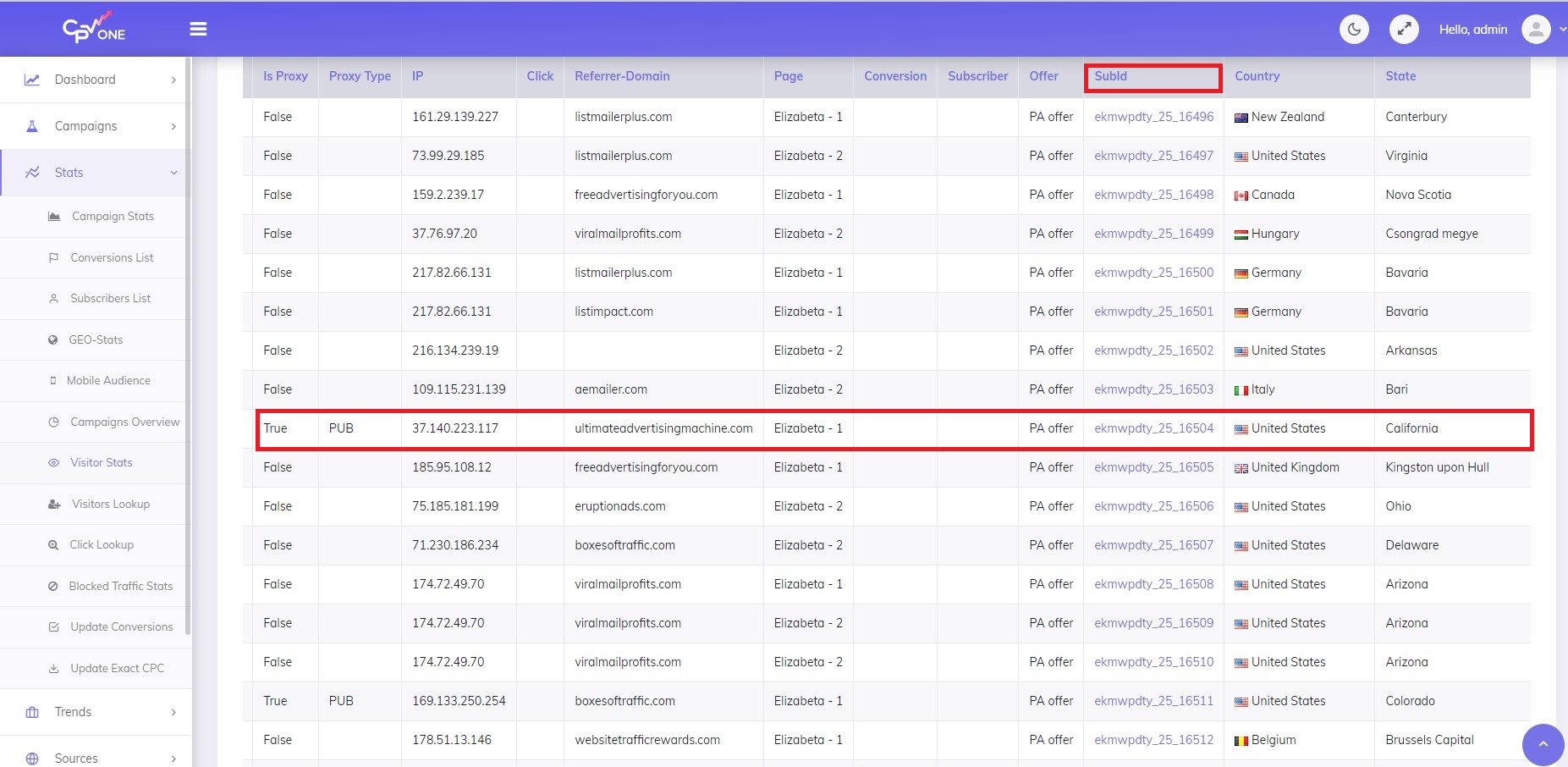
In the visitor statistics section, you’ll find all the basic information you need. But if you’re looking for something more detailed, you can click on the’subid’ of any visitor.
This is like a unique code for each visitor. When I clicked on the subid of the first person who visited our page using a proxy, I got a lot more detailed information about them. It’s a great way to really understand who’s coming to your site.
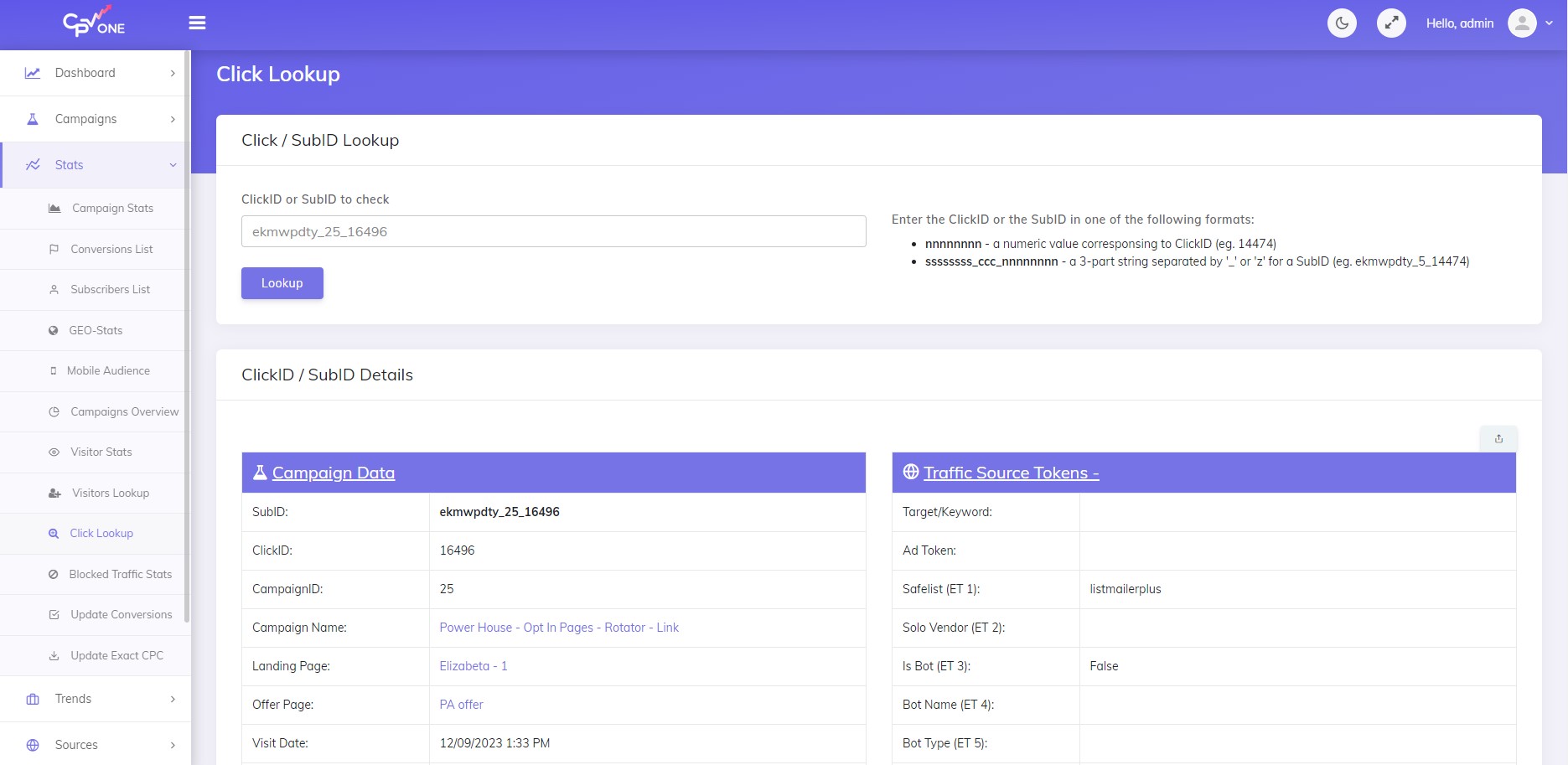
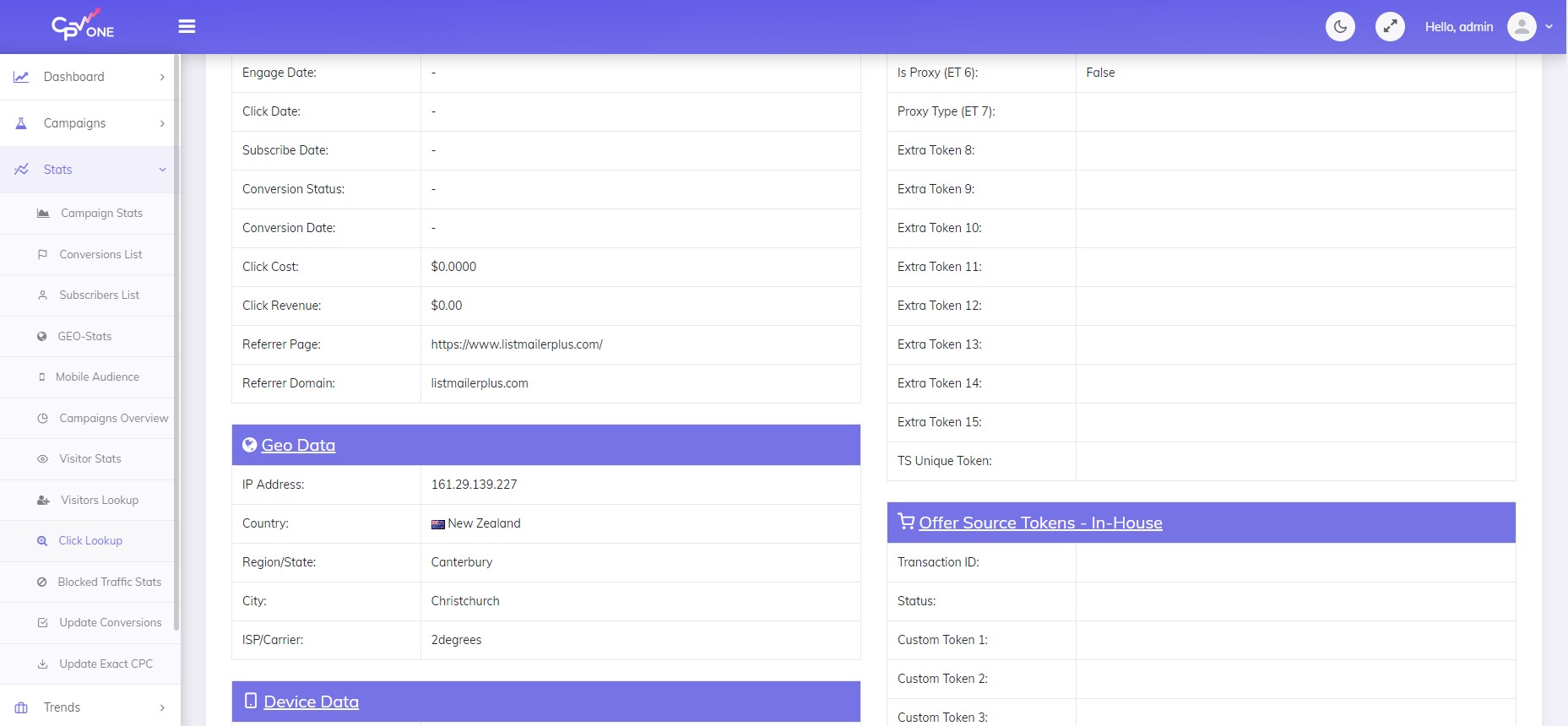

Blocking unwanted traffic:
Once you realize specific IP addresses are tied to bots, you can block these IPs at your traffic source. This helps cut down on unwanted bot traffic. But remember, bots often switch their IP addresses, so you’ll need to keep updating your blocklist.
In my case, I don’t actually have bot traffic, but I’ll use the proxy ID as an example to show you how to block it. If you start getting bot traffic, you’ll notice a pattern where many clicks come from the same IP or a range of similar IPs. This kind of traffic can really mess up your analytics and give you misleading key performance indicators (KPIs).
Bots can fake clicks and create false traffic, making your conversion rates look worse. If you ignore bot detection, you can waste your marketing budget and get inaccurate data about your ads’ performance.
That’s why it’s crucial to block this traffic and not count it as part of your real traffic. You can do this by going into your settings and looking for the ‘blocked traffic rules’ section.
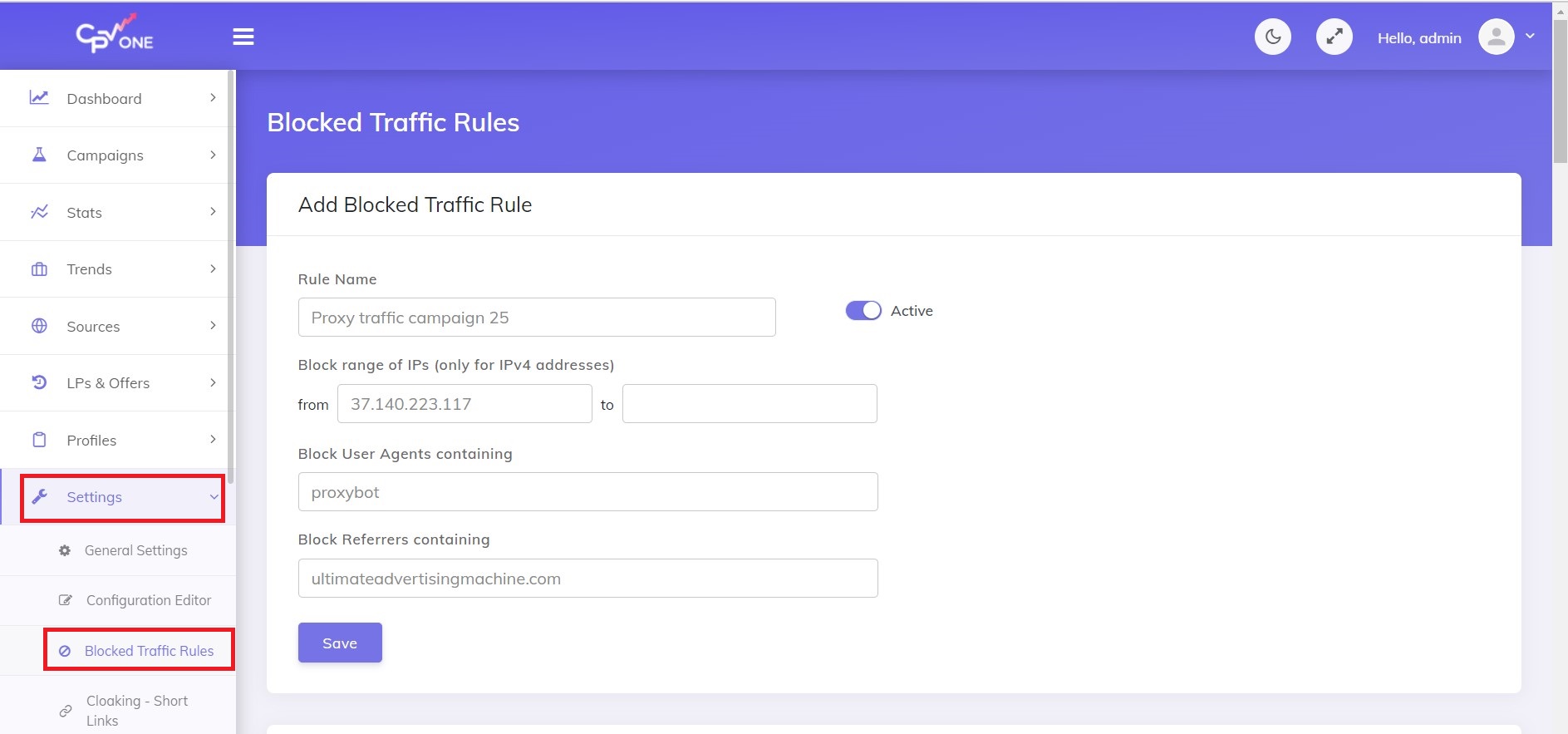
Setting Up Traffic Blocking Rules
- Rule Name
- What to do: Give a name to your rule for reference.
- Example: In our case, you might name it based on the specific action or target, like “Proxy traffic campaign 25”.
- Block Range of IPs
- Single IP: You can block a single IP address. For example,
10.0.0.11. - IP Range: You can also block a range of IP addresses. For instance, from
10.0.0.1to10.0.0.11. - Our Case: We are blocking the IP
37.140.223.117.
- Single IP: You can block a single IP address. For example,
- Block User Agents Containing
- Purpose: This refers to a functionality where you can block or filter out traffic from certain ‘user agents’. A user agent is a string that identifies the browser, operating system, and device type of the person visiting your website. This information is sent to the server each time a request is made to load a webpage.
- How to do it: You enter a string that can be a part of the user agent or the entire user agent: You can specify a certain text string that, if found in the user agent, will trigger the blocking or filtering action. For example, entering “Googlebot” will block or filter out all traffic from Google’s web crawling bot. If this string is present in the user agent for incoming traffic, it will not count in the Stats. This implies that any visit to your website from a user agent containing the specified string will not be included in your website’s traffic statistics. It is a way to ensure that visits from well-known bots, crawlers, or any other traffic sources you deem irrelevant or potentially harmful do not skew your analytics data. In practical terms, this feature is used to improve the accuracy of website traffic analysis. By filtering out known bots or specific types of visitors (like internal traffic from your own company), you get a clearer picture of real, human visitor patterns and behaviors on your site.
- Our Case: We’ve used “proxybot” as the string to block.
- Block Referrers Containing
- Function: This functionality allows you to set a filter based on the text found in the referrer URL. A referrer URL is the URL of the previous webpage from which a link was followed to reach the current page. It’s a way to track how users are navigating to your site.
- How to do it: Enter any text that will be present in the referrer URL: You can specify a particular string or text. If this text is found in the referrer URL, the tool will trigger a block or filter action. For instance, if you enter “example.com”, any traffic from URLs containing “example.com” will be subject to this rule. If this text matches an incoming referrer URL, it will not count in the Stats: When a referrer URL containing the specified string directs traffic to your website, that traffic will be excluded from your site’s traffic statistics. This is useful for ensuring that your analytics data isn’t affected by traffic from specific sources you want to exclude. For example, you might want to exclude visits from a specific website or a set of websites for various reasons, such as skewing your traffic data, being a known source of spam traffic, or any other reason. Ability to block traffic containing a specific text in the referrer: This phrase emphasizes that you have control over blocking traffic from referrers that contain certain text. This can be particularly useful for blocking spam traffic, filtering out visits from specific domains, or managing the quality of traffic for more accurate data analysis.
- Our Case: We added a specific domain to block. It’s important to test before blocking domains broadly.
- Active/Inactive Rules
- Activating a Rule: The rule will start working if you check the ‘Active’ option.
- Flexibility: You can keep rules either active or inactive as needed.
- Edit/Delete Rule
- Management: Once a rule is created, you can find it in a table at the bottom of the page.
- Options: Each rule will have ‘EDIT’ and ‘DELETE’ options to modify or remove it as required. To see results go to Statistics/Block Traffic statistics
- Blocked Traffic Stats
- Tracking: This section shows all blocked traffic details, including the date/time, IP, user agent, and the reason for blocking.
- Note: Since the rule is just set, data might not be immediately available.
Remember, these rules are crucial for managing the quality of your traffic and CPA lead generation campaigns and ensuring your analytics reflect genuine user interactions.
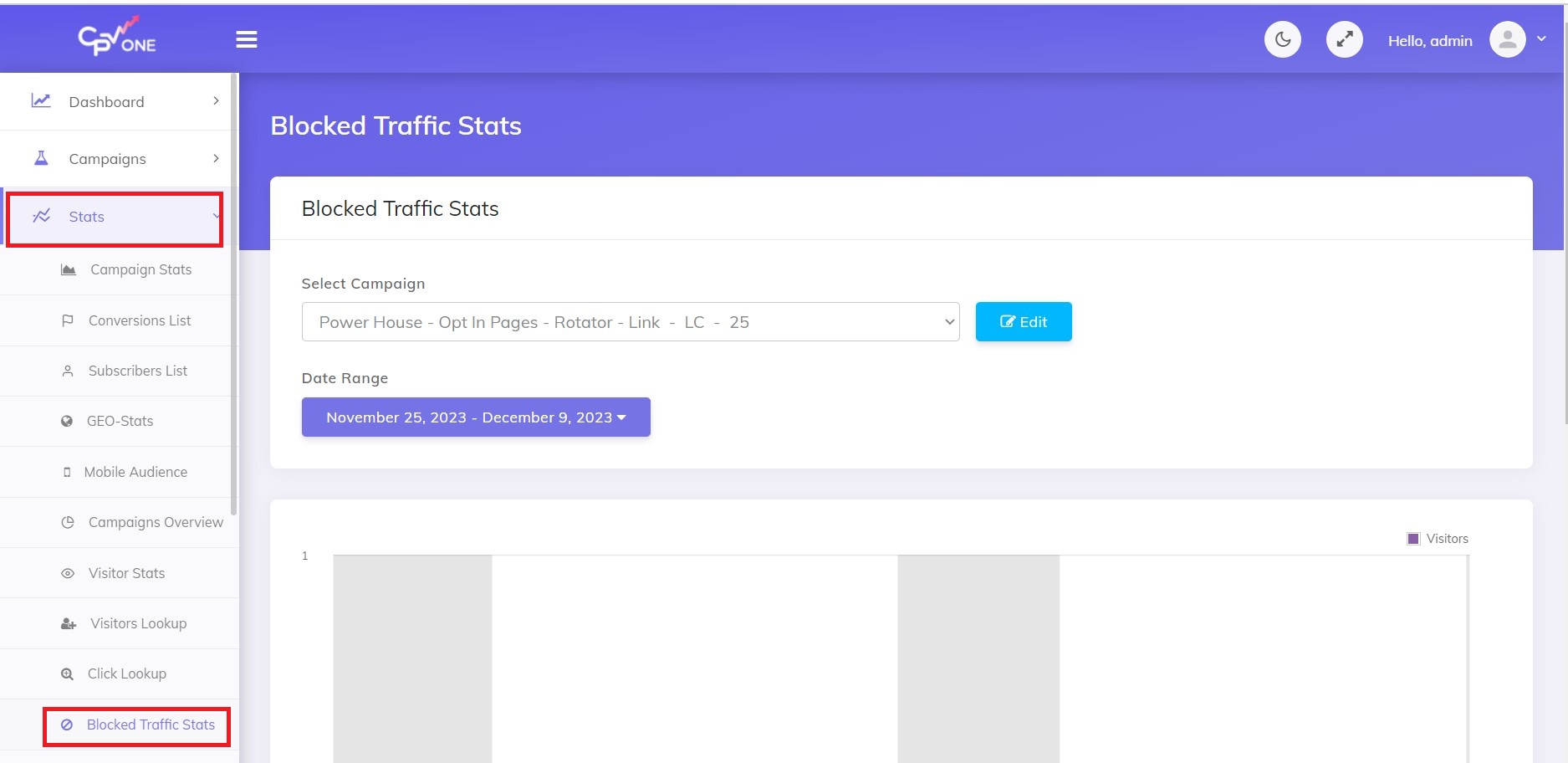
Handling Traffic Sources and Bot Traffic in CPV One
Remember, while you can’t completely stop bot traffic from entering your links, these measures in CPV One help you manage and mitigate its impact on your campaigns.
Dealing with Traffic Sources:
When you analyze your traffic sources and find a significant percentage of bot traffic, you can take informed steps. For instance, you can contact your traffic source and request not to pay for bot traffic or consider discontinuing the use of that traffic source if it doesn’t meet your quality standards.
Redirecting Bot Traffic:
To maintain good standing with offer owners and avoid being penalized for sending low-quality traffic, CPV One enables you to redirect bot traffic to a specific page or destination. This way, the offer owner receives traffic that is more likely to be of high quality and genuine interest.
You can find more about redirecting website bot traffic in the CPV documentation.
Strategic Benefits:
These features are particularly beneficial for testing new traffic sources, optimizing ad spend, and ensuring your marketing efforts focus on reaching potential customers. You can improve your campaigns’ overall effectiveness and ROI by filtering out low-quality traffic.
CPV One’s ability to handle bot and proxy traffic and its other features make it a valuable tool for advertisers, affiliate marketers, and media buyers. It provides the necessary functionality to ensure your marketing campaigns are efficient, targeted, and yield high-quality traffic.
Preventing Website Bot Activity in Lead Generation
In addition to identifying bot activity, businesses must focus on preventing bot activity in lead generation. By adhering to industry standards, conducting regular audits, replacing traditional captchas, and screening affiliates and partner agencies, businesses can minimize bot traffic, lead gen fraud, and fake leads.
Adhering to Industry Standards and Best Practices
Adhering to industry standards and best practices is essential for effective bot detection and lead generation fraud prevention. Implementing best practices for bot detection ensures lead generation program integrity, real traffic, and effective marketing efforts.
Conducting Regular Audits and Checks
Regular checks and audits help maintain lead generation efforts free from fraudulent activity, lead gen fraud, and fake leads. By implementing regular audits and checks, businesses can detect bot patterns, address fraudulent traffic, and maintain website traffic authenticity.
Replacing Traditional Captchas with Advanced Techniques
Advanced techniques, such as behavior analysis, help in distinguishing between real users and bot traffic, ensuring lead generation success, lead scoring accuracy, and effective marketing efforts. By replacing traditional captchas, businesses can effectively prevent bot activity, fake clicks, and fake traffic.
Screening Affiliates and Passive Bot Fingerprinting
Passive bot fingerprinting is a technique used to detect website bots. It works by analyzing the behavior of the incoming traffic to determine whether it’s coming from a human or a bot. The fingerprinting process considers various factors, including mouse movements, keystrokes, and browser configurations. With this information, website owners can identify and block bots that harm their site’s performance or security. Passive bot fingerprinting effectively protects websites from malicious attacks and keeps them running smoothly for human users.
Partner Agencies
Screening affiliates and partner agencies is crucial for lead generation program success. Using bot detection techniques, businesses can screen affiliates and partner agencies for fraudulent activity, fake leads, and invalid traffic. By utilizing AI for lead generation and screening affiliates and partner agencies, businesses can ensure genuine leads, lead data integrity, and effective lead generation efforts. You can find more in the powerhouse affiliate training courses, which explain affiliate marketing in depth.
Finding the Right Balance in Bot Detection and Lead Generation
Finding the right balance in bot detection and lead generation is essential for maximizing conversion rates, lead scoring accuracy, and user experience. Balancing bot detection techniques with lead generation efforts ensures genuine user information, real leads, and effective marketing efforts. By finding the right balance, businesses can minimize fraudulent traffic, fake leads, and lead gen fraud, maximizing lead generation program success.
Conclusion
In conclusion, the importance of detecting and addressing bot activity for effective lead generation cannot be overstated. Bots can adversely affect the quality of leads, lead to wasteful expenditure on advertising, and harm the credibility of your online presence. Effective website bot detection is integral to a successful lead generation strategy, and it often involves a sophisticated mix of AI, machine learning, and behavioral analysis.
This website bot detection process differentiates real human interaction from bots by analyzing various metrics. These include mouse movements, browser fingerprinting, and user interactions on mobile apps and social media platforms. By effectively managing bot activities such as web scraping, DDoS attacks, spam, and fake user account creation, these solutions ensure the authenticity of user data, like page views and bounce rate, in analytics tools like Google Analytics.
CPV One emerges as a viable solution in this context. Its advanced tracking and detection capabilities can significantly enhance your ability to discern and manage bot traffic, thus ensuring the integrity of your lead generation efforts. CPV One’s features allow for a nuanced approach to bot detection, ensuring that genuine users are not deterred while keeping malicious bots at bay.
However, it’s crucial to maintain a delicate balance in your website bot detection strategy. Overly aggressive measures may deter genuine users, negatively impacting your lead generation efforts. Regular auditing and fine-tuning of your bot detection techniques, with tools like CPV One, are essential to optimize lead generation without compromising on user experience.
If you want to implement CPV One in your lead generation strategies for B2B or need assistance optimizing your bot detection techniques, feel free to reach out for support. With the right tools and lead-generation strategies, you can protect your digital assets effectively and ensure a fruitful lead-generation process.



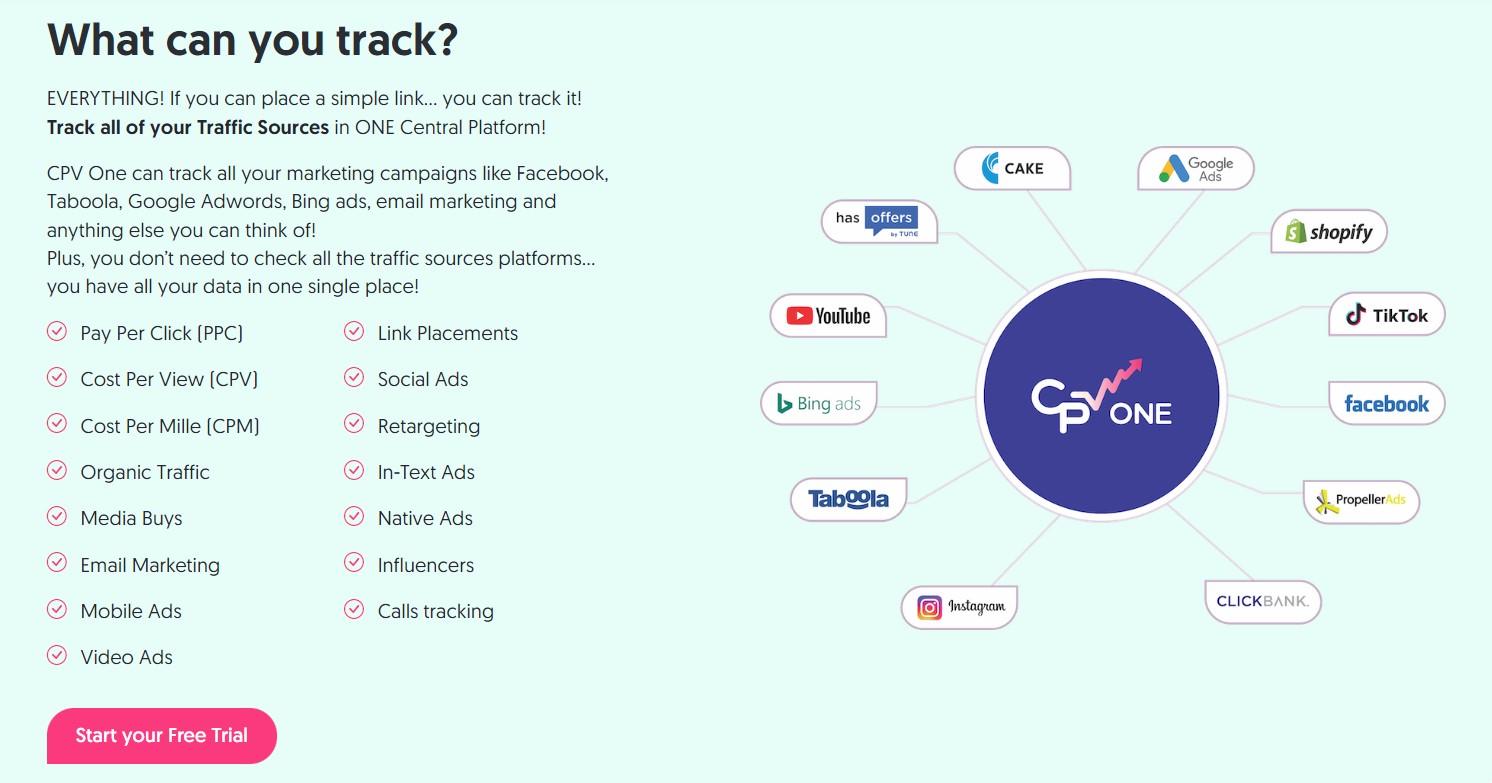
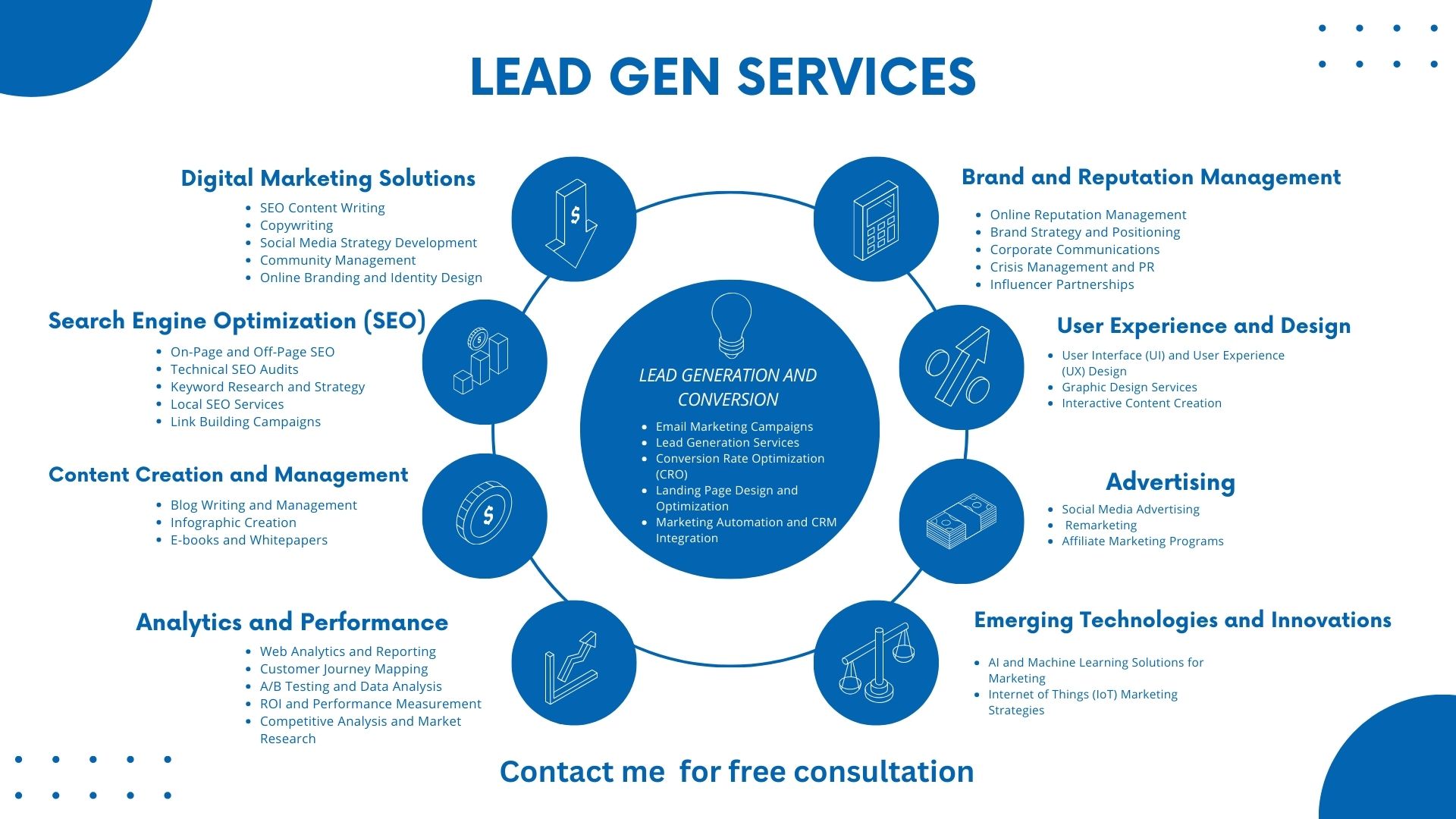
No responses yet